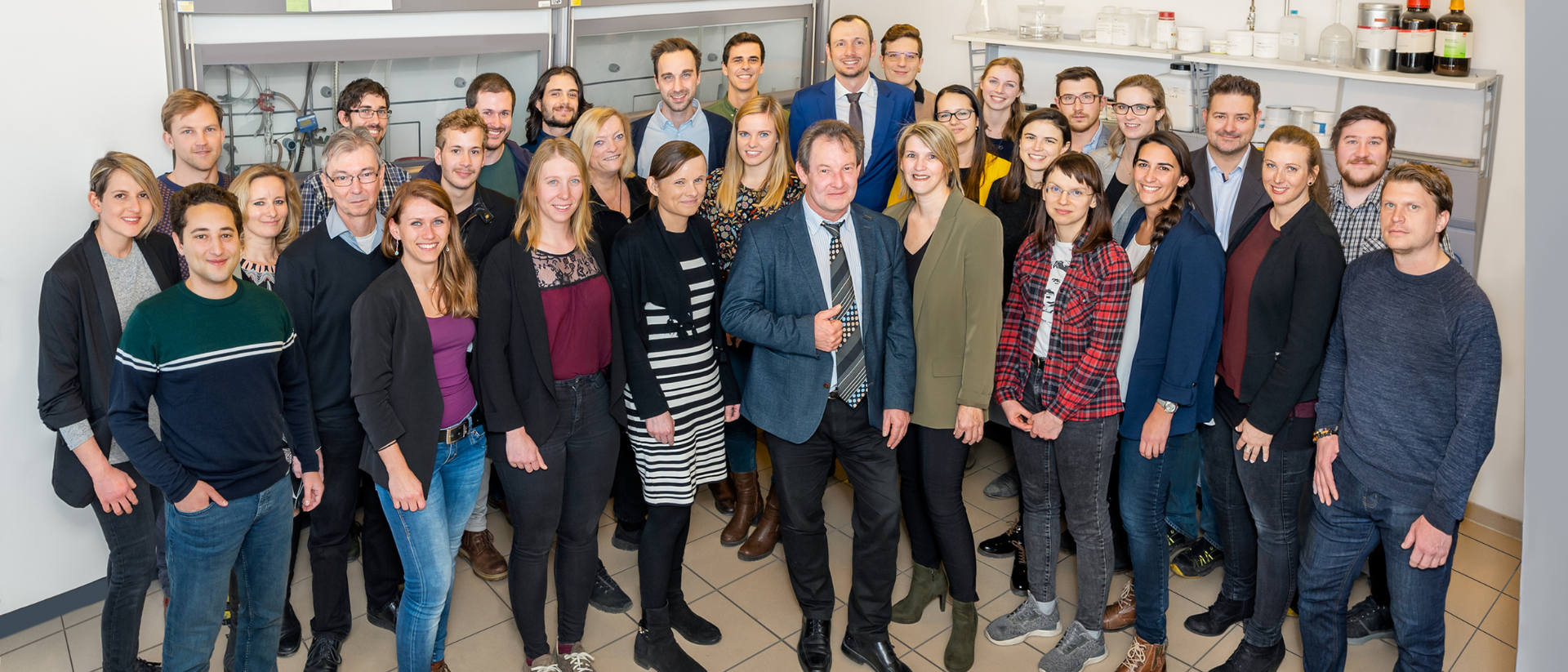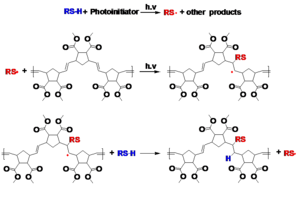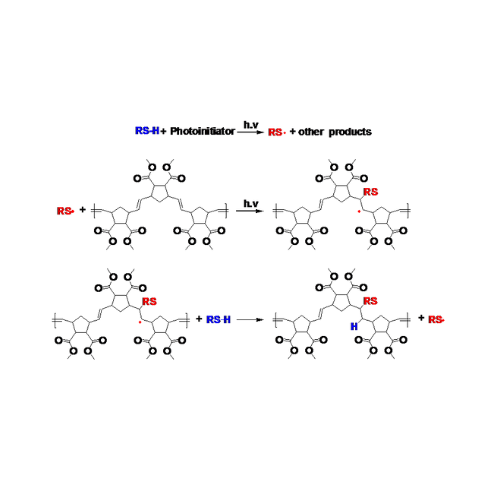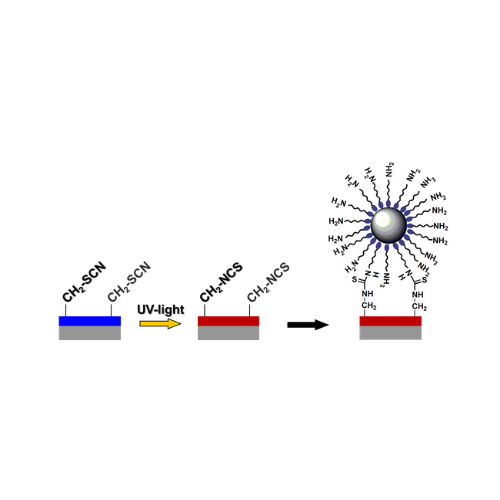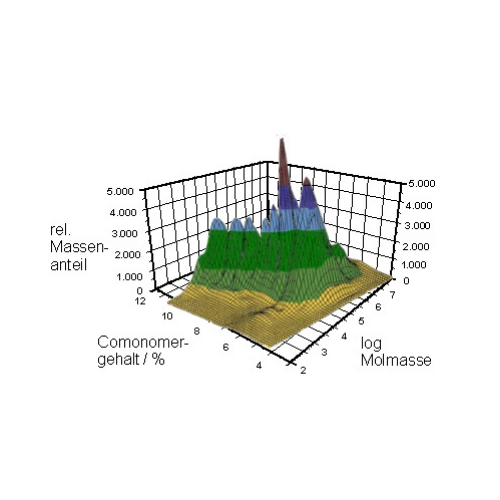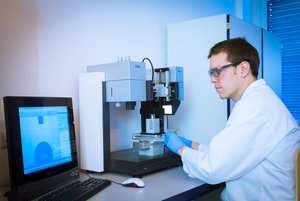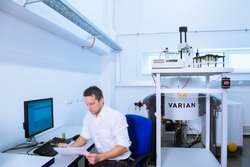Chemistry of Polymeric Materials
With respect to research and teaching, the Chair of Chemistry of Polymeric Materials is active in the fields of macromolecular chemistry, physical chemistry of polymeric materials, and molecular characterization of polymers. Special topics in research are, e.g., the photochemistry of polymers, surface- and interfacial chemistry, as well as the technology of functional (nano) composites. Cooperative research projects are conducted together with other universities, and also with industrial companies and non-university R&D institutions.
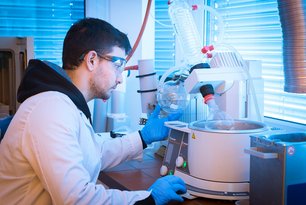
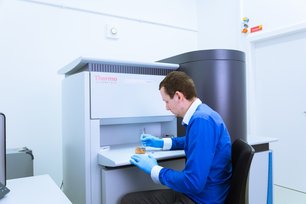
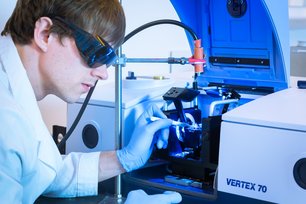
Our Team
Head of Institute

Univ.-Prof. Mag.rer.nat. Dr.techn. Wolfgang Kern
+43 3842 402 - 2350
wolfgang.kern(at)unileoben.ac.at
Profil (Pure)
CV & List of Publications
Office Management

Claudia Wieser
Office Chemistry of Polymeric Materials
claudia.wieser(at)unileoben.ac.at
+43 3842 402 - 2301

Michelle Puscher
michelle.puscher@unileoben.ac.at
+43 3842 402 - 2364

Groupleader

Ao.Univ.-Prof. Dipl.-Chem. Dr.rer.nat. Nicolai Aust
nicolai.aust(at)unileoben.ac.at
+43 3842 402 - 2309
Research:

Ass.Prof. Dipl.-Chem. Dr.rer.nat. Gisbert Rieß
gisbert.riess(at)unileoben.ac.at
+43 3842 402 - 2311
Profile (Pure)
Research:

Univ.-Prof. Dipl.-Ing. Dr.techn. Thomas Griesser
thomas.griesser(at)unileoben.ac.at
+43 3842 402 - 2358
further information
Research:
Employees, graduate students and post-graduate students
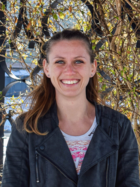
Dipl.-Ing. Dr.mont. Christine Bandl
christine.bandl(at)unileoben.ac.at
+43 3842 402 - 2306
Profile (Pure)
Research:


Gema del Carmen Guedes de la Cruz
gema-del-carmen.guedes-de-la-cruz(at)unileoben.ac.at
+43 3842 402 - 2390
Profile (Pure)
Research:






Mohammadhossein Sharifian, Karsh.A.
mohammadhossein.sharifian@unileoben.ac.at
+43 3842 402 - 2305
Research:

Laboratory Technicians

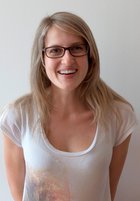
Janine Billiani
janine.billiani@unileoben.ac.at
+43 3842 402 - 2385
Teaching
Teaching
The Chair of Chemistry of Polymeric Materials plays an active role in the education of students in the field of Polymer Science and Engineering. Teaching comprises the principles of organic polymer chemistry, physical chemistry of polymeric materials as well as selected topics of industrial applications (e.g. coatings technology, fibre materials, elastomers and functional additives) both in lectures and in laboratory courses.
Moreover, elective subjects are devoted to more specialized topics such as polymer photochemistry, polymers in biomedical applications, materials for electronics as well as the technology of adhesives). Numerous external lecturers from industry complement the range of teaching of our chair.
Publications
For a list of current publications please follow the link on the right side.
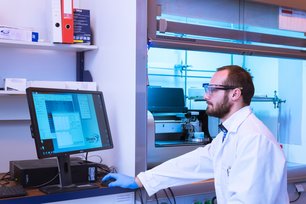
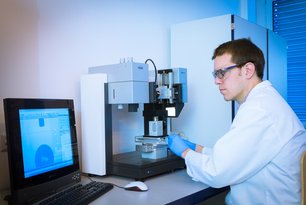
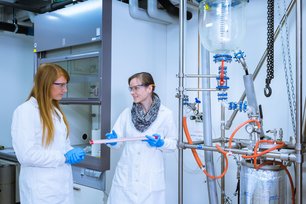
Research & Projects
With respect to research, the Chair of Chemistry of Polymeric Materials is active both on a fundamental level and on a technological level. Whilst fundamental research aims at the study of new polymeric materials and processes, technological research is in many cases being conducted together with industrial companies and non-university research organizations such as the Polymer Competence Center Leoben (PCCL) see www.pccl.at.
Multidisciplinary approaches, a strong interaction with polymer engineering, and a vivid collaboration with international research partners are the cornerstones of our research. The early involvement of students (bachelor and master level) in research projects is another element of our research policy, and significantly contributes to the academic education and professional experience of young engineers.
The main research fields of the chair of Chemistry of Polymeric Materials are:
This research field aims at the modulation of the properties of polymeric materials by the use of UV light. Light is employed to induce the polymerization of selected monomers, to crosslink e.g. elastomeric materials and to achieve the functionalization of surfaces. A few examples are given in the following.
Making use of thiol-ene photochemistry, the UV-induced modification and crosslinking of various polymers bearing C=C unsaturated units is a continuous topic of research. As an example, ring opening metathesis polymerization derived poly(norbornene) films and aggregates were crosslinked via photo chemically induced thiol-ene chemistry using a multifunctional thiol and the double bonds present in the polymers backbones. Although internal unactivated double bonds are not particularly
reactive in this transformation, even stericaly encumbered double bonds have been proven to be reactive enough to be crosslinked with a multifunctional thiol in the presence of a radical photoinitiator. The reaction can also be used to crosslink self assembled aggregates of amphiphilic block copolymers in a selective solvent.This method can be illustrated by the description of a negative-toned photoresist formulation. The general reaction scheme and examples for lithographic patterns (after patterned illumination, and after subsequent development) are shown on the right side (Picture 1 & 2).
A spectacular project, which is being run together with PCCL and our company partner Semperit AG, aims at the photoassisted vulcanization of natural rubber (NR) latex in a falling film photoreactor. Based on thiol-ene photocross-linking, the pre-vulcanization is carried out without the use of conventional vulcanization accelerators which may cause type-IV allergies. UV pre-cured latex films are distinguished by good physical properties (tensile strengths up to 26 MPa) as well as good skin compatibility considering skin sensitization and irritation potential. The results of this work indicate that the new process makes the manufacture of non allergenic (concerning latex induced Type IV hypersensitivity) dipped NR latex articles feasible, e.g. surgical NR latex gloves. This PCCL project has received the„Science-2-Business Award“ of the Austrian Federal Ministry BMWJF in 2009 and has resulted in several international patents. The picture shows the falling film photoreactor (3000 Watt power) in action (Picture 3).
Advancing from one-photon photochemistry to two-photon photochemistry, 3D structures can be produced by laser writing using two-photon induced photopolymerization. On a technological level, we have employed this principle to realize optical interconnects (waveguides) in printed circuit boards. This method involves embedding optoelectronic components in a polymeric material and fabricating optical waveguides in one step. A silanol terminated polysiloxane cross linked with an acryloxy functional silane is utilised as a matrix material into which the 3D optical waveguides are inscribed by two-photon-induced polymerisation. A pulsed femtosecond laser is used to directly write optical waveguides into the material, forming an optical link between lasers and photodiodes which are directly mounted on a specially designed printed circuit board (PCB). With these optical structures, data rates exceeding 4 Gbit/s were achieved. This project has been performed with PCCL and our industrial partner AT&S in close collaboration with JOANNEUM Research (Weiz).
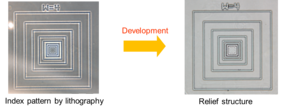
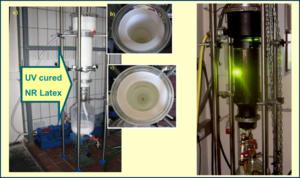
The surface modifation of polymers plays an important part in the enhancement of the performance of basic polymers and offers new approaches toward the development of tailored materials for specific applications. Whilst the activation of polymer surfaces by corona and plasma treatments is a well established technique (and is performed in our labs as a standard method), the functionalization of functional polymer surfaces with (nano)particles is pursued on a scientific level.
Intrinsically photoreactive polymers are mainly applied as photoresists which rely on the alteration of solubility upon UV irradiation. However, by using specific photoreactive groups, which undergo photoinduced isomerizations, also the surface properties (e.g. polarity and chemical reactivity) can be modulated. This is e.g. realized with photosensitive co-polymers of styrene and 4-vinylbenzyl thiocyanate, which are employed for the immobilisation of aminofunctionalized silica nanoparticles (SiO2-NP) at the polymer surface. Upon UV irradiation of the co-polymer, isothiocyanate (NCS) groups are generated by a photo-isomerisation reaction of the thiocyanate (SCN) groups. The silica nanoparticles are selectively immobilised in irradiated areas by the formation of thiourea links. By using photolithographic methods, patterned silica structures (?m scale) were produced on the polymer surface. The SiO2-NP covered surfaces are of potential interest to generate protective surface layers and to carry out further functionalization reactions of the immobilized SiO2-NP particles.
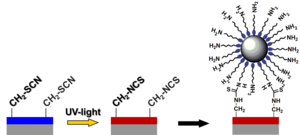

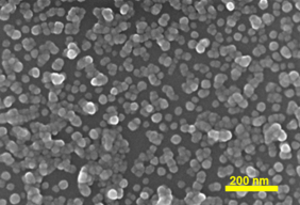
Plastic materials mainly consist of polymers (macromolecules) and a set of additives, which modify, influence, and retain the end-use properties of the plastics.
The mechanical useful properties (e.g. tensile strength, hardness, modulus, impact strength) are mainly influenced by the composition and phase structure of the polymers. Therefore, an understanding of the structure-property relationship is necessary for the development of new polymers with defined characteristics.
At the Chair of Polymeric Materials numerous techniques are available which allow detailed characterization of polymers, e.g. according to their molar mass distribution, comonomer content, and degree of short-chain or long-chain branching:
- Room- and High Temperature Size Exclusion Chromatography (SEC);
- Analytical and preparative fractionation techniques, such as Temperature Rising Elution Fractionation (TREF), Crystallization Analysis Fractionation (CRYSTAF), and Holtrup Fractionation.
The experimental equipment also includes a coupling of high performance liquid chromatography with mass spectrometry (HPLC/MS-coupling) to analyse additives as well as their decomposition products in plastic materials.
Especially for low molar mass components the 400 MHz NMR-spectrometer is another important and powerful tool for a precise molecular characterization.
The research area of Molecular Characterization also includes the development and refinement of analytical methods with statistical models which help to understand phase separation and phase transistion of polymers. The results achieved hereof can be eventually applied to optimize the experimental conditions during analyses.
Cooperation Partner (selection)
Scientific
- The University of Sheffield (GB)
- Department of Chemistry
- Universität Paderborn (D)
- Lehrstuhl für Technische und Makromolekulare Chemie
- Lehrstuhl für Kunststofftechnologie
- Technische Universität Graz (A)
- Zentrum für Elektronenmikroskopie
- Joanneum Research Materials (A)
Industry
- Durst Digital Technology GmbH (A)
- Getzner Werkstoffe (A)
- RHI AG (A)
- AT&S (A)
- Mediscan (A)
Equipment
Corona treatment is very common in in-line printing processes of foils and offers a polar surface modification technique for unpolar polymer materials. It attaches oxygen moieties on the surface of the sample and thus improves the lamination and printing properties of the polymer materials for instance. In addition the activation of the polymer surface can be used to attach certain chemical groups in a post-modification process aiming at the manufacture of tailored surface properties.
High temperature size exclusion chromatography is used for the determination of molar mass distribution and long chain branching of polymers soluble only at elevated temperatures.
Main field of application is the analysis of polyolefins, e.g. PE, PP, as well as their copolymers made thereof.
LC-MS/MS is a coupling of two different techniques, HPLC (high performance liquid chromatography) and mass spectroscopy (MS). HPLC separates molecules according to their different adsorption behaviour and is combined with MS, an additional separation and analytical procedure. Main field of application is the identification of organic stabilizer systems in plastics.
Characteristics of the LC-MS/MS system
Mass range from m/z 50 up to m/z 2000 amu at a scan rate of at least 5500 amu/s
Sensitivity for small molecules in the lower nmol/L range
MS part:
3D Ion trap with automativ gain control to prevent overloading
Ion sources: ESI and APCI
Ionisation modi: positiv and negativ
HPLC part:
Quartary gradient system (flow range: 2 up to 2000 µL/min)
Degasser, auto sampler, column oven, photo diode array detector
The "PREP-mc2 plus" system of PolymerChar allows an automated fractionation of polymers according to their molar mass and composition where a maximum of fifteen fractions of the polymer can be obtained in a semi-preparative scale. Fractionation can be carried out in one, or parallel, in two reactors.
Fractionation according to molar mass (homopolymers and copolymers): The polymer is dissolved at a constant temperature in solvent/non-solvent-mixtures of various quality. Fractions of increasing molar mass are obtained and transfered into collecting bottles for further preparation.
Fractionation according to composition (branched homopolymers and copolymers):
At an elevated temperature the polymer is dissolved in an appropriate solvent and the solution obtained subsequently cooled down using a constant temperature gradient. Due to different precipitation or crystallization behaviour of the phases of the polymer, fractions of various degree of branching or composition are obtained. Subsequent heating using discrete temperature steps leads to a successive dissolution of the different phases which are transfered into collection bottles for further preparation.
The PolymerChar TREF 200+ is used to calculate the distribution of side chains and the composition of polymers and copolymers (composition distribution). It is based on the principal that different polymer fractions crystallise differently in solution.
Fractioning occurs in a two-step process. In the crystallisation step, the different polymer fractions form onion-like layers around an inert TREF packing material during cooling. Due to the different crystallisation behaviour of the different fractions, the degree of short chain branching increases with the number of layers.
In the second step the polymer fraction layers are solved at increasing temperature and eluted. The degree of short chain branching of the eluted fractions degreases with increasing temperature. Detection is by means of infra red radiation at constant wavelength.
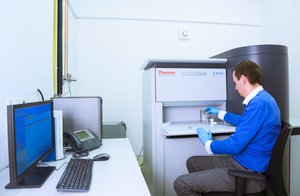
X-ray photoelectron spectroscopy, also known as Electron Spectroscopy for Chemical Analysis (ESCA) is a highly sensitive surface analysis technique. The basic idea behind this spectroscopic technique is the determination of the elemental composition as well as chemical and electronical states within the top atomic layers of the samples. Except hydrogen and helium nearly every element can be detected.
XPS spectra itself are gained by irradiation of materials with sufficiently high energy, i.e. X-rays. Consequently, a special form of photoemission is generated. In this process an electron of the inner core shell (K shell) gets excited and leaves the sample. With the determination of the recorded kinetic energy, the binding energy of the electrons ejected can be calculated and thus, the parent element and atomic energy level are determined. By recording the energies of the photoelectrons ejected a spectrum is obtained where peaks corresponding to the energy bands of core levels are displayed.
Specifications:
Characterization methods: depth profiling, mapping, insulator analysis
Lateral resolution: 30 µm
Energy resolution: 0.5 eV
Source-defined analysis area: 30 - 400 ?m
Step size: 5 ?m (ensures that the analysis area closely matches the feature to be analyzed)
CD Laboratory for Functional and Polymer Based Inkjet Inks
The Christian Doppler Laboratory (CDL) for Functional and Polymer Based Inkjet Inks started in January 2012 and ended in December 2020 and targets at novel concepts for UV-curable inkjet inks, with a strong focus on non-irritant and eco-friendly materials.
Together with the industrial partners Schmid Rhyner AG, Lithoz GmbH and Wollsdorf Leder Schmidt & Co Ges.m.b.H. new inkjet inks for advanced applications in the fields of optics and bio-medicine are investigated. This research project is subdivided into two strongly interconnected topics dealing with novel UV-curable, non-irritant and bio-compatible inkjet inks and the fabrication of functional materials using multilayer 2D and 3D inkjet printing.
Partner




Laboratory Director
Univ.-Prof. Dipl.-Ing. Dr.techn. Thomas Grießer
+43 3842 402 - 2358
Research
The current research of the Christian Doppler Laboratory focuses on the development and investigation of novel UV-curable, functional inkjet ink concepts with a strong focus on non-irritant and eco-friendly materials. These inks are expected to be food-proof and thus can be used for the printing onto food packaging materials and labels, and also for inkjet printing on textiles and garments. Furthermore, with these new inkjet inks advanced applications in the fields of optics and bio-medicine are realized.
The research work is divided into three interconnected research topics:
focuses on the chemistry of functional UV-curable inkjet inks, which are non-irritant and provide eco- and bio-compatibility. To achieve this goal, alternative radical based curing reactions are explored on a fundamental level to substitute (meth)acrylate monomers/oligomers in conventional ink formulations.
deals with the development and investigation of highly efficient photoinitiators providing low migration in the post-cured materials. For that purpose novel copolymerizable and biocompatible photoinitiators are investigated.
deals with the fabrication of biocompatible 3D structures for the realization of medical implants (e.g. scaffolds and vascular grafts) by means of multilayer 2D and 3D inkjet printing. Moreover, the fabrication of flexible and even stretchable optical devices using 2D multilayer inkjet printing is investigated within this research topic.

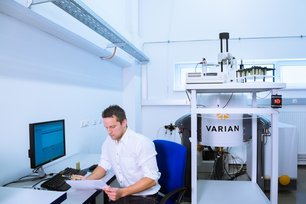
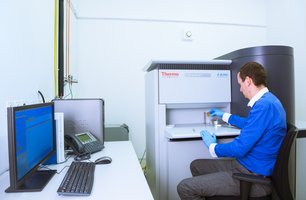
Contact & Directions
Chair of Chemistry of Polymeric Materials
Otto Glöckel-Straße 2
8700 Leoben, Austria
+43 3842 402 2301
polychem(at)unileoben.ac.at
Office
4th floor straight ahead of the elevator.
